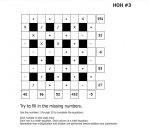You are using an out of date browser. It may not display this or other websites correctly.
You should upgrade or use an alternative browser.
You should upgrade or use an alternative browser.
Math Square
- Thread starter TheJuice
- Start date
Guess and Check is definitely a good strategy. But, you need not blindly check every possibility. Personally, I'd start with the bottom two rows. There's one division and no multiplication, so you know the division must result in a whole number. So, the number before the division sign cannot be prime (EDIT: Whoops! Unless the number after it is 1), and the number after the division sign must be a factor of the one before. That heavily restricts your possibilities. And on the bottom row, you know the result of the division plus the two unknowns can be no more than 52 (you can subtract up to 25, to equal 27).
Then if you find a combination you think seems promising for one row, assume it's true and work on an intersecting column. Keep going until you either fill in the whole board or get a contradiction. Then resolve that contradiction and resume. It may be tedious at times, but hopefully not difficult.
Then if you find a combination you think seems promising for one row, assume it's true and work on an intersecting column. Keep going until you either fill in the whole board or get a contradiction. Then resolve that contradiction and resume. It may be tedious at times, but hopefully not difficult.
Last edited:
I think you can do a little bit better than pure guess and check by synthesizing math knowledge and guess and check. You have 25 unknowns (let's index them by row and column) and only 10 equations, but you have a raft of inequations plus the knowledge that every unknown is an integer.
What struck me initially is that 351 has only two prime factors, namely 3 and 39. That is applying math knowledge. Then the number of possible guesses is greatly reduced.
\(\displaystyle 351 = 3 * 117 = 3^2 * 39 \implies \text { Case A: } x_{1,5} = 39 \le 25 \text { impossible, }\)
\(\displaystyle \text {Case B: } x_{1,5} = 3 \implies x_{1,1} + x_{1,2} + x_{1,3} + x_{1,4} = 117 \le 94 = 25 + 24 + 23 + 22 \text { impossible }\)
\(\displaystyle \implies \text {Case C: } x_{1,5} = 9.\)
EDIT: Denis has pointed out that I slipped a cog (or twenty) in what I wrote above. That logic assumes that
\(\displaystyle (x_{1,1} + x_{1,2} + x_{1,3} + x_{1,4}) * x_{1,5} = 351.\)
That of course is completely wrong.
\(\displaystyle x_{1,1} + x_{1,2} + x_{1,3} + x_{1,4} * x_{1,5} = 351 \implies\)
\(\displaystyle 351 - 25 - 24 - 23 \le x_{1,4} * x_{1,5} \le 351 - 1 - 2 - 3 \implies\)
\(\displaystyle 279 \le x_{1,4} * x_{1,5} \le 345.\)
What struck me initially is that 351 has only two prime factors, namely 3 and 39. That is applying math knowledge. Then the number of possible guesses is greatly reduced.
\(\displaystyle 351 = 3 * 117 = 3^2 * 39 \implies \text { Case A: } x_{1,5} = 39 \le 25 \text { impossible, }\)
\(\displaystyle \text {Case B: } x_{1,5} = 3 \implies x_{1,1} + x_{1,2} + x_{1,3} + x_{1,4} = 117 \le 94 = 25 + 24 + 23 + 22 \text { impossible }\)
\(\displaystyle \implies \text {Case C: } x_{1,5} = 9.\)
EDIT: Denis has pointed out that I slipped a cog (or twenty) in what I wrote above. That logic assumes that
\(\displaystyle (x_{1,1} + x_{1,2} + x_{1,3} + x_{1,4}) * x_{1,5} = 351.\)
That of course is completely wrong.
\(\displaystyle x_{1,1} + x_{1,2} + x_{1,3} + x_{1,4} * x_{1,5} = 351 \implies\)
\(\displaystyle 351 - 25 - 24 - 23 \le x_{1,4} * x_{1,5} \le 351 - 1 - 2 - 3 \implies\)
\(\displaystyle 279 \le x_{1,4} * x_{1,5} \le 345.\)
Last edited:

